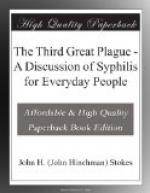+The Treatment of Syphilis With Salvarsan.+—Salvarsan, the original “606,” was improved on by Ehrlich in certain ways, which make it easier for the ordinary physician to use it. The improved salvarsan is called neosalvarsan ("914”) and has no decided advantages over the older preparation except on the score of convenience. Both salvarsan and neosalvarsan are yellow powders, which must be manufactured under the most exacting precautions, to prevent their being intensely poisonous, and must be sealed up in glass tubes to prevent their spoiling in the air. They were formerly administered by dissolving them or by mixing with oil and then injecting them into the muscles, much as mercury is given by injection. At the present time, however, the majority of experts prefer to dissolve the drug in water or salt solution and to inject it into the blood directly, through one of the arm veins. There is very little discomfort in the method, as a rule—no more than there is to the taking of blood for a blood test. At the present time the quantity of the drug injected is relatively small for the first injection, growing larger with each following injection. The intervals between injections vary a good deal, but a week is an average. The number of injections that should be given depends largely on the purpose in view. If the salvarsan is relied on to produce a cure, the number may be large—as high as twenty or more. If it is used only to clear up a contagious sore, a single injection may be enough for the time being. But when only a few injections are used, mercury becomes the main reliance, and a patient who cannot have all the salvarsan he needs should not expect two or three doses of it to produce a cure. The publicity which has been given to this form of treatment has led many patients to take matters into their own hands and to go to a physician and ask him to give them a dose of salvarsan, much as they might order a highball on a cold day. The physician who is put in a position like this is at a disadvantage in caring for his patient, and the patient in the end pays for his mistaken idea that he knows what is good for himself. The only judge of the necessity of giving salvarsan, and the amount and the frequency with which to give it, is the expert physician, and no patient who is wise will try to take the thing into his own hands. There are even good reasons for believing that the patient who is insufficiently treated with salvarsan is at times worse off than the patient who, unable to afford the drug at all, has had to depend for his cure entirely on mercury.
It is one of the tragedies of the modern private practice of medicine that the physician has so often to consult the patient’s purse in giving or withholding salvarsan, and for that reason, except in the well-to-do, it is seldom used to the best advantage. Such a drug, so powerful an agent in the conservation of the public health, should be available to all who need it in as large amounts as necessary, without a




